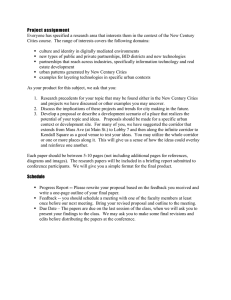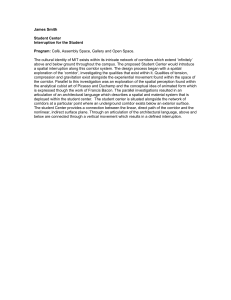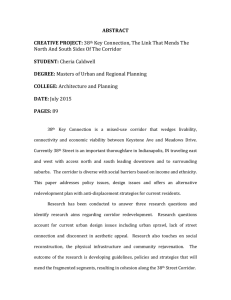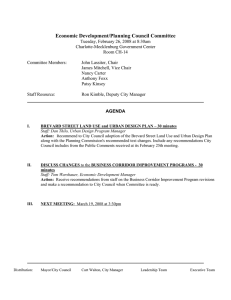“Southern Africa Growth Belt Initiative Phase 2”
advertisement
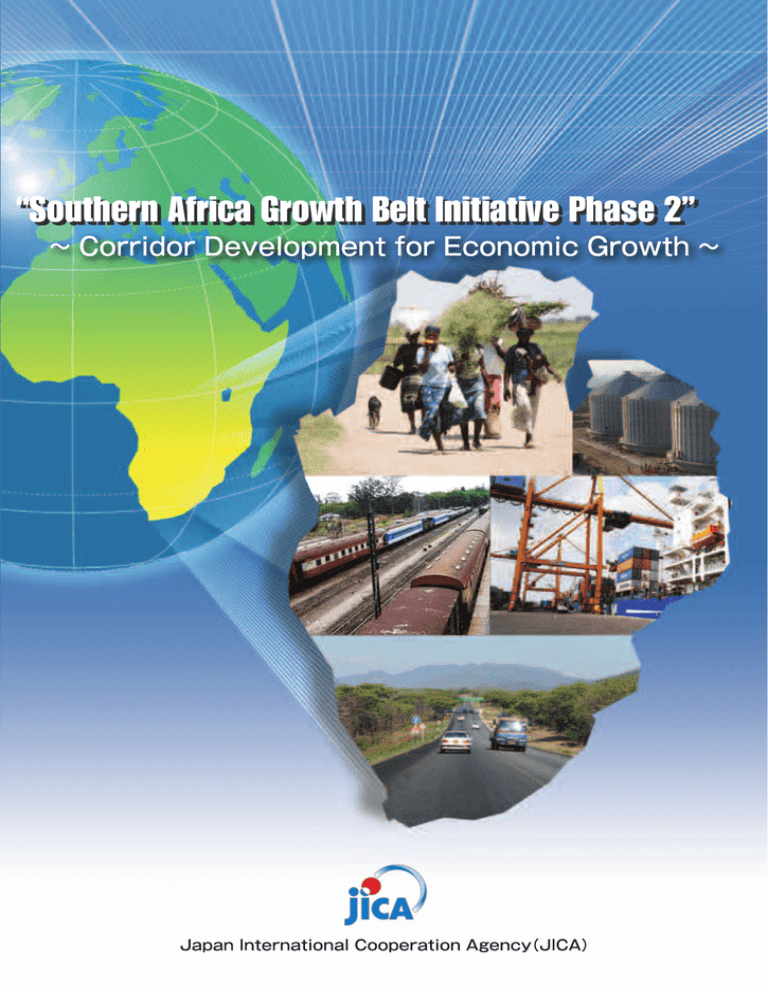
“Southern “Southern Africa Africa Growth Growth Belt Belt Initiative Initiative Phase Phase 2” 2” 1 Southern Africa An Attractive Destination for Investment Southern Africa is projected to grow rapidly in terms of population and GDP, and is becoming an attractive destination for investment by foreign enterprises. At the same time, the region needs to accelerate the pace of job creation, increase agricultural productivity, and improve food security. GDP Growth Population Growth Millions 500 40% 60% 80% Southern Africa UP 200 2,000 Oceania 1,500 Latin America 1,000 2010 0 Europe 2035 UP 500 Asia 0 USD billions (2010 prices) 2,500 Other Africa Northern America 100 2 20% 0% 400 300 GDP Projections for Southern Africa (2010–35) Population Growth Rate Projections by Region (2010–35) Population Projection for Southern Africa (2010–35) 2010 2035 Greatest Driving Forces for Regional Growth It is envisaged that industrial development in Southern Africa over the next 20 years will be driven mainly by: (i) agriculture and agro-industry; and (ii) mining and downstream industries, especially basic materials industries. I. Key Driver: Agriculture and Agro-Industry Urgent Need to Improve Agricultural Productivity Decline in Annual Cereals Production per Capita 450 South Africa 400 350 kg per capita Declining Trend Zimbabwe 300 Angola Botswana Malawi Malawi 250 Mozambique 200 Namibia Zambia 150 South Africa Zambia 100 Zimbabwe 150 0 4 1-6 6 19 9 5-6 6 19 4 0-7 7 19 9 5-7 7 19 4 0-8 8 19 9 5-8 8 19 Agricultural Development Will Lead to Increased Intra-Regional Trade Recent Share of Intra-Regional Trade in Total Trade 0% Southen Africa European Union Asia North America South America 20% 4 0-9 9 19 80% 60% 40% Low share in Southern Africa at present 9 5-9 9 19 4 0-0 0 20 -10 05 20 Photo Credit: Akio Iizuka (Zambia) Measures to be Urgently Implemented and Expected Outcomes Productivity growth in cereals production Diversification toward higher-value products ・Reduced reliance on food imports from the global market ・Increased intra-regional trade Increased agro-industry production ・New formal-sector jobs (expansion downstream) ・Stabilized food prices Geographical diversification ・Increased real wage levels of production II. Key Driver - Mining and Basic Materials Industries The mining and manufacturing sectors in Southern Africa will develop vertically from mineral resources extraction, which is a major strength of the Southern African economy, to downstream industries. Envisioned Development in Southern Africa Significant Increase Expected in Mining and Basic Materials Production Vertical development Present Situaion Mineral/Energy Resources Extraction Exports Current Production Increased production Global Market Input Basic Materials Production Currently, production in the region is very limited Create Intra-Regional Industrial Linkages (Example) ・Natural gas extracted offshore ・Phosphate rock mining 3 Envisioned Future (20 years later) Fertilizer production in the region Agriculture and agro-industry Several large-scale production/export bases Regional Market Example: Envisioned Large-Scale Basic Materials Industries Heavy chemicals industry (including fertilizer production) Copper fabrication Iron and steel industry Aluminum fabrication Corridor/Regional Infrastructure Development Achievement of the industrial development in Southern Africa envisaged above requires a corridor/regional development approach (infrastructure and human capacity development) including the following: Tranport Sector Road - Improve poor sections along major corridors - Develop efficient intermodal systems Power Sector Water Sector Generation Water supply - Address critical shortage of power - Promote funding for generation projects - Reduce non-revenue water and water losses - Construct dams to supply raw water - Construct water treatment facilities and pipelines Trade/Transport Facilitation Border/Customs Procedures - One-stop border posts - Coordinated border management - Regional custom bond guarantee schemes Railway - Revitalize railways in the region to meet increasing demand for the transport of bulk commodities and long-distance freight Port - Expand port handling capacity to meet increasing demand for both global and intra-regional trades Photo Credits: JICA Study Team Transmission - Strengthen transmission interconnectors within the Southern African Power Pool (SAPP) and link the SAPP with other regional pools Irrigation - Rehabilitate existing irrigation facilities - Construct dams to provide irrigation water - Extend irrigated area Transport Procedures - Road transport market liberalization - Harmonization of vehicle dimensions and axle load limits - Harmonization of road user charges for foreign vehicles 4 Assessment of Major Economic Corridors A. Eight Priority Corridors Selected in 2010 JICA Study Corridor Prioritization in 2010 JICA Study Analyses Undertaken 18 Corridors Assessed DRC Angola - Corridor Development Analysis - Benefit/Cost Analysis - Socio-Economic Indicator Analysis Tanzania Malawi Zambia Zimbabwe Namibia Eight Priority Corridors Mozambique Botswana South Africa DRC Angola Tanzania Malawi Zambia Zimbabwe Beira Corridor Dar es Salaam Corridor Lobito Corridor Maputo Corridor Nacala Corridor North-South Corridor Trans-Caprivi Corridor Trans-Kalahari Corridor Namibia Mozambique Botswana South Africa Source: JICA, Preparatory Survey for Southern Africa Integrated Regional Transport Program (2010) http://www.jica.go.jp/activities/issues/transport/pdf/SAGB_eng01.pdf B. Industrial Development Potentials Potential for Development of Two Key Drivers: Agriculture and Agro-Industry, and Mining and Downstream Industries Beira Corridor Nacala Corridor Dar es Salaam Corridor North-South Corridor Lobito Corridor Trans-Caprivi Corridor Maputo Corridor Trans-Kalahari Corridor • Agriculture and agro-industry along the Beira Agricultural Growth Corridor (BAGC) in Mozambique, and in Zimbabwe • Offshore natural gas in Pande/Temane, and downstream industries in Beira, Mozambique • Coal and coal-fired power generation in Tete Province, Mozambique • Various kinds of mineral extraction and downstream industries in Zimbabwe • Agriculture and agro-industry along the Southern Africa Growth Corridor of Tanzania (SAGCOT) and along the corridor in Zambia • Offshore natural gas in southern Tanzania and downstream industries in the coastal area • Coal, iron ore, and downstream industries in Iringa Province, Tanzania • Agriculture along the corridor particularly in Angola • Copper and iron ore and downstream industries in multi-facility economic zones and industrial parks in Zambia as well as in the Democratic Republic of Congo • • • • Production of high-value commercial crops in Limpopo Province, South Africa Platinum group metals, coal, iron ore, and diamonds in South Africa Chemical industries, and iron and steel production along the corridor Offshore natural gas and associated fuel production (e.g. naphtha, kerosene, light oil) in Maputo, Mozambique • Agriculture and agro-industry along the corridor in Mozambique (including in the Pro-Savana Project area), central and southern Malawi, and Zambia • Natural gas in the Rovuma offshore area and downstream industries • Coal in Tete Province, Mozambique • Various kinds of minerals and downstream industries in Malawi • Copper, iron ore, coal, and downstream industries in Zambia • Agriculture and agro-industry along the corridor in Zambia, Zimbabwe, northeastern Botswana, and eastern South Africa • Various kinds of minerals along the corridor that traverses the countries with high potentials for mining, i.e., eastern Botswana, South Africa, Zambia, and Zimbabwe (e.g., copper, iron ore, nickel, coal, platinum, chrome, manganese, ferrochrome), and downstream industries in these countries • Agro-processing in the Walvis Bay Export Processing Zone, Namibia • Uranium in the mid-eastern part of Namibia • Copper processing and smelting in northern Namibia • Coal and energy development in southern Zambia • Agro-processing in Windhoek and the Walvis Bay Export Processing Zone, Namibia • Uranium in the mid-western part of Namibia • Copper fabrication in the vicinity of production areas along the corridor African Development Community C. Southern (SADC) Regional Infrastructure Development Master Plan (RIDMP), 2012 Priority of Corridors in 2012 SADC RIDMP High • North-South Corridor • Maputo Corridor • Dar es Salaam Corridor Note: Only the eight priority corridors are presented. Medium • • • • • Trans-Kalahari Corridor Beira Corridor Nacala Corridor Trans-Caprivi Corridor Lobito Corridor Photo Credit: Hiromi Nagakura (Mozambique) a. Synergistic Investment by Japanese Companies • Concentration in South Africa • As of 2013, Japanese companies in the Southern African region are concentrated in South Africa. • Development along the North-South and Maputo Corridors is expected to attract Japanese companies further. • Major Investment Projects by Japanese Companies outside of South Africa Beira and Nacala Corridors: coal mining Maputo Corridor: aluminum production Nacala Corridor: natural gas exploration North-South Corridor: production of parts/components of machinery for mining b. Recent/Ongoing JICA Assistance In recent years, JICA has been actively supporting the development of the Nacala and North-South Corridors. Nacala Corridor 5 • Corridor development strategies • Agricultural development • Roads and bridges • Port of Nacala • Industrial development • Social Infrastructure (middle school, human resource training, etc.) • Access to water, sanitary improvement • Forest monitoring Photo Credit: Hiromi Nagakura (Mozambique) NorthSouth Corridor • Kazungula Bridge • One stop border posts • Development of economic zones • Power system development • Investment promotion Photo Credit: Akio Iizuka (Zambia) Proposal for Potential Focus Economic Corridors Overall Assessment and Proposed Potential Focus Corridors for JICA Assistance Development Potential: Relationship with Japan: investment by A. Priority in 2010 JICA Study a. Existing/potential Japanese companies along the corridors for development of + B. Potential two key drivers Recent/ongoing JICA assistance b. for corridor development Priority in 2012 SADC RIDMP C. Proposed Potential Focus Corridors: Nacala Corridor North-South Corridor (Note: Assistance for other corridors will not be ruled out.) 6 Profile of Proposed Focus Corridors Nacala Corridor Major Development Potentials Agricultural Development • Along Nacala - Nampula - Cuamba - Mandimba - Lichinga, Mozambique • Central and southern regions, Malawi • Along Chipata–Lusaka, Zambia Mining Development • Natural gas extraction offshore in northern Mozambique • Coal mining around Tete and Niassa Provinces, Mozambique • Heavy metal sands, rare metals, uranium, coal in Malawi • Copper, iron ore, coal along the Copperbelt, Zambia • Nickel, phosphate rock, other minerals in northern Mozambique Agro-Industrial Bases • Nacala, Nampula, Cuamba, Mandimba, Lichinga, and Gurúè (Zambezia Province), Mozambique • Blantyre and Zomba, Malawi • Lusaka and Chipata, Zambia Industrial Bases (e.g., Basic Materials Industries) • Nacala Special Economic Zone, Mozambique • Points along the Nacala railway line in Malawi • Lusaka and major regional cities along the Copperbelt, Zambia Tanzania DRC Malawi Angola Zambia Zimbabwe Namibia Mozambique Botswana South Africa Photo Credit: JICA Study Team (Mozambique) Legend Business/Industrial Center Chemical Industry Tobacco Nuts Mineral Resources Li : Lithium Logistics/Industrial Center Metal Industry Cassava Coffee Au : Gold Ni : Nickel Agro-Business Center Manufacturing Industry Potatoes Tea Ag : Silver P : Phosphate Mining-Business Center Food Processing Industry Citrus/Fruits Cotton Bx : Bauxite PGM: Platinum Group Metal RE : Rare Earth Cement Production C : Coal Airport Mushrooms Sisal (Textile) Cr : Chromite Se : Selenium Port Fertilizer Production Sesame Livestock Dairy Cu : Copper Sn : Tin Inter-Modal Terminal Irrigation Development Beans Fish Dm : Diamonds Ta : Tantalum Thermal Power Water Supply Development Tomatoes / Tomato Sauce Floriculture Fe : Iron ore Ti : Titanium Hydropower Micro Finance for SMMEs Vegetables Banana Gm : Gemstones U : Uranium Railway Capacity Development Wheat Jatropha (Biofuel) Gra: Granite W : Tungsten Zn : Zinc Maize Ls : Limestone Oil Pipeline Rice Sugarcane (Biofuel) Mn : Manganese Zr : Zircon Sugarcane Sorghum Millet NG : Natural Gas Related Recent/Ongoing JICA Assistance Project for Nacala Corridor Economic Development Strategies, Mozambique Tropical Savannah Agriculture Development Program -Japan-Brazil-Mozambique Triangular CooperationMozambique Nacala Port Management Financial assistance for several road/bridge Improvement Project projects along the Nacala Corridor, Mozambique Mozambique Project on Promoting Sustainability in Rural Water supply, Hygiene and Sanitation in Niassa Province, Mozambique Study of Potential Industries, Malawi Financial assistance for several road/bridge projects, Malawi Photo Credit: Koji Sato (Malawi) North-South Corridor Major Development Potentials Agricultural Development • Along Copperbelt–Lusaka–Livingstone, Zambia • Central, eastern, and southern Zimbabwe • Eastern Botswana • Eastern South Africa Agro-Industrial/Light Manufacturing Bases • Multi-facility economic zones, Zambia • Harare, Bulawayo and Masvingo, Zimbabwe • Francistown and Gaborone, Botswana • Durban and eastern South Africa Mining Development • Copper, iron ore, coal along the Copperbelt, Zambia • Various minerals in central Zimbabwe • Eastern Botswana • Northeastern South Africa Industrial Bases (e.g., Basic Materials Industries) • Durban and eastern South Africa • Harare, Bulawayo, eastern Zimbabwe • Eastern Botswana • Lusaka and major regional cities along the Copperbelt, Zambia Related Recent/Ongoing JICA Assistance Kazungula Bridge Construction Project, Botswana/Zambia One-Stop Border Post at Chirundu, Zambia/Zimbabwe Development of Industrial Strategy, Zambia Angola Malawi Zambia Zimbabwe Namibia Zambia Investment Promotion Project– Triangle of Hope, Zambia 7 Tanzania DRC Master Planning Study of Lusaka South Multi-Facility Economic Zone, Zambia Mozambique Botswana South Africa Photo Credit: JICA, Kazungula (Botswana/Zambia) Proposed Critical Public Sector Actions Actions Critically Needed for the Development of Regional Corridors Industrial Development • Modernization of agriculture and agro-industry • (Re)development/modernization of mining • Promotion of industrial zone and related development • Development and promotion of clusters for small and medium enterprises Infrastructure Development • Road improvement, revitalization of railways, intermodal facilities, port expansion/development • Power generation and transmission, pipeline transport • Enhancement of water supply, irrigation development Capacity Development • Extension services, technical assistance for small and leading local farmers • Technical and vocational education and training, development of industrial management skills • Reduction in nonrevenue water and water losses • Capacity development in the railway and port sectors • Capacity development of the Southern African Power Pool • Capacity development of infrastructure facility O&M technical experts Trade/Transport Facilitation Photo Credit: JICA Study Team (Mozambique) Photo Credit: • Assistance for implementation of improved corridor transit, coordinated border JICA Study Team (Zambia) management, one-stop border posts, port facilitation, and railway transport facilitation Photo Credit: Clockwise from Top Left: 1. Hiromi Nagakura (Mozambique) 2. Akio Iizuka (Zambia) 3. Yasuji Shoji (Zimbabwe) 4. Hiromi Nagakura (Mozambique) Front Cover Photo Credit: Clockwise from Top Left: Hiromi Nagakura (Mozambique), Others by JICA Study Team This study examined potential JICA technical and financial assistance for industrial and infrastructural development along major economic corridors in Southern Africa in the transport, power, and water sectors. Shin-Onarimon Bldg. 6-17-19 Shinbashi, Minato-ku Tokyo 105-0004 Japan Tel: +81-3-5733-0855 Fax: +81-3-5733-0856 4, Kojimachi 5-chome Chiyoda-ku, Tokyo 102-8539, Japan Tel: +81-3-5276-3596 Fax: +81-3-5276-3002 2013.5 500
